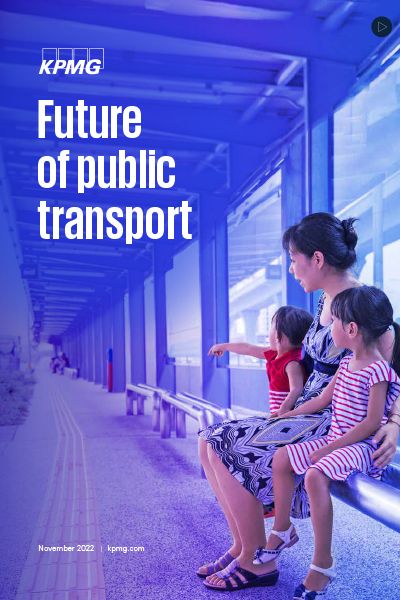The landscape is changing rapidly as the public transport sector looks to leave the impact of COVID-19 behind and boldly embrace the future. Traditionally provided by heavily subsidized public-sector bodies operating discrete/siloed transport modes, the traditional model of public transport service delivery is being challenged as never before. New market entrants are changing the last-mile equation through enhanced services and convenient new offerings. Priorities are shifting as decision-makers listen to the voice of their constituents and look beyond the operation of transport infrastructure, fleets and workforce to fully consider the advantages of a connected, 21st-century ecosystem
KPMG International, in a commissioned survey conducted by Forrester Consulting, engaged 483 leaders from public transportation organizations across the globe to understand their perspectives on the sector’s future. The report explores the potential that a connected public transport system has in forging powerful enterprise-wide business and delivery models that can drive excellent customer experience while enhancing efficiency and contributing to the prosperous future we all want to see.
Explore the signals of change below and download the full report to see what leaders from around the world are predicting on the future of public transport.
Explore the six signals of change
Customer and community expectations are changing. They are demanding services that are digital, personalized to their needs and preferences, accessible and equitable.
Public transport is a key enabler of sustainable economic growth and equitable opportunity. Leaders should balance the need for investment with the long-term financial sustainability of the state.
The need to decarbonize and minimize pollution is becoming central to public transport and place planning for the future. Environmental sustainability is becoming a key focus area of reporting and reflective of the demand for greater transparency.
Emerging digital technologies are disrupting the status quo. New operational technology is in the early phases of reshaping networks and is expected to link with customer, asset and enterprise technologies that enhance operations and decision-making around services.
Mobility-as-a-Service and autonomous vehicles have the potential to be cost-competitive with public transport services. This introduces a new level of competition for ridership and presents the need for public transport services to ‘attract’ customers in order to maintain the financial sustainability while delivering environmental and social outcomes.
The speed of innovation increasingly exceeds the rate at which traditional regulatory systems can adapt, presenting an inherent challenge for public transport regulators. Regulation frameworks should become more dynamic in order to respond to emerging modes and new private-sector players – helping to ensure safe, controlled, seamless experiences.
Stay informed
The email address you've entered is already tied to an existing account. Please login to access your requested content.
KPMG thought leadership is always available to our registered users
You’ve successfully logged in.
Please close this pop-up in order to get back to the page.
Please provide the following information to register.
Get in touch with us
Connect with us
- Find office locations kpmg.findOfficeLocations
- kpmg.emailUs
- Social media @ KPMG kpmg.socialMedia


